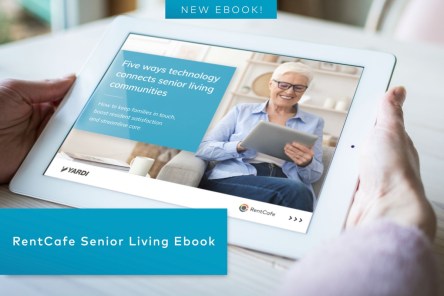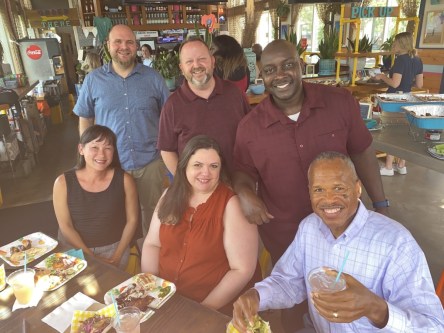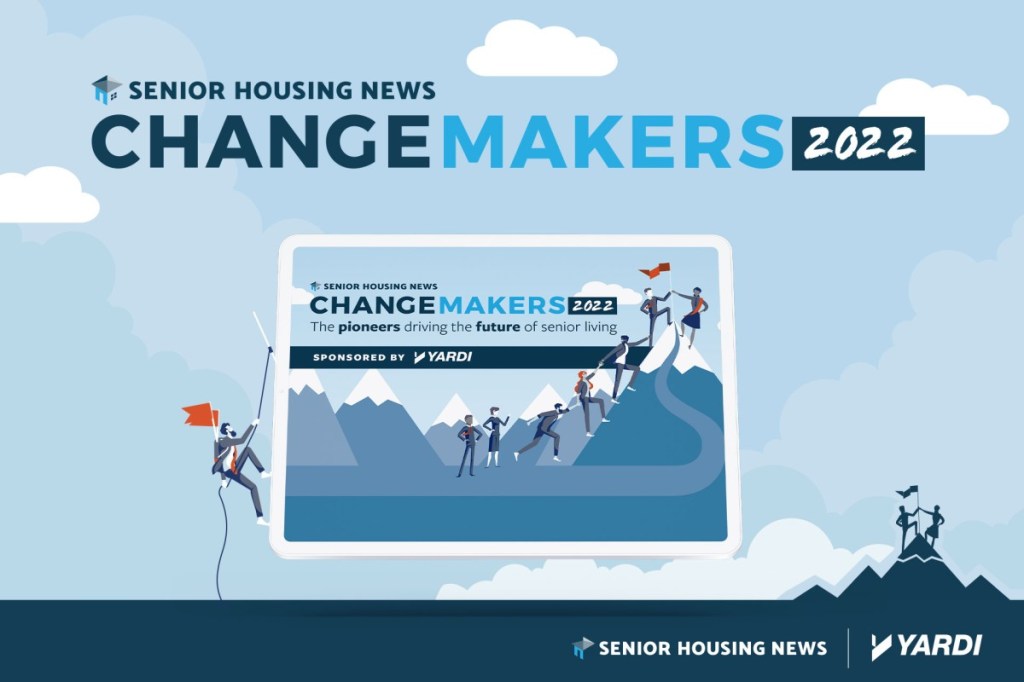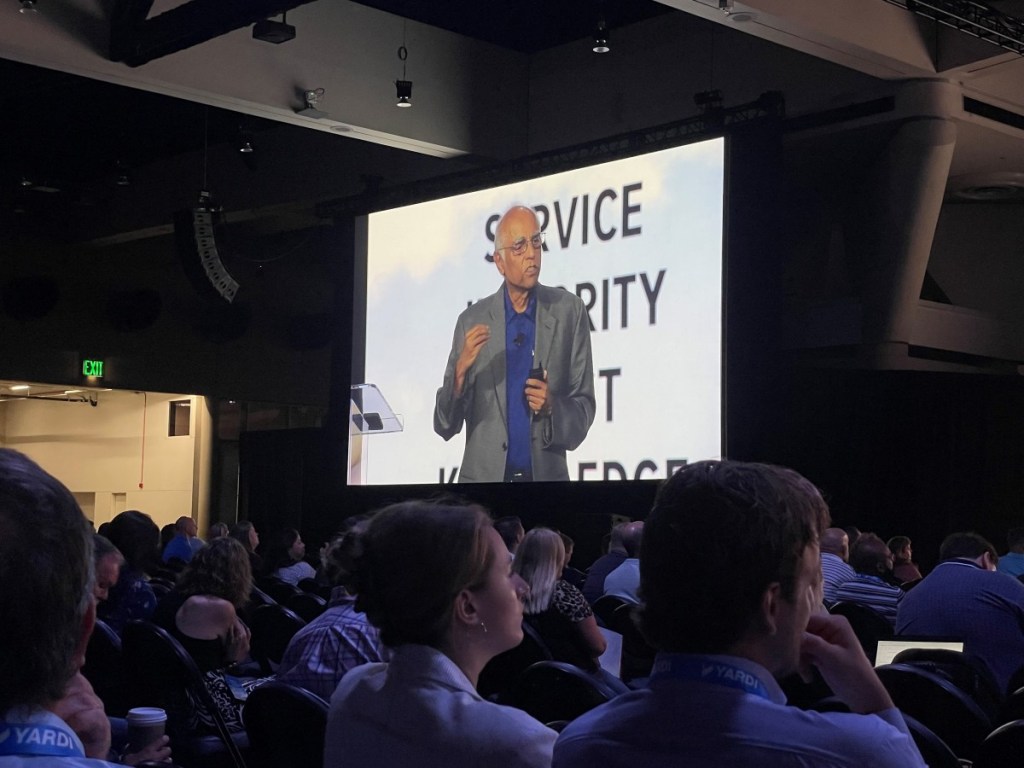If you’re planning to attend SMASH 2022, the Senior Care Marketing and Sales Summit, you’ll get the chance to network with innovative sales and marketing professionals in senior living. Taking place in Las Vegas, there’s no event quite like it in the industry. We’re proud to be a platinum sponsor of this one-of-a-kind event, scheduled for October 24-26 at the Green Valley Resort. If you’re set to attend, we can’t wait to meet you! Team Yardi will be in attendance and looks forward to connecting throughout the two and a half-day experience. About SMASH 2022 What makes SMASH 2022 different? Simply put, the SMASH conference is exclusive to sales and marketing executives in senior care. That allows for a value-packed few days where attendees receive takeaways applicable to their role. The agenda was crafted to meet the needs of sales and marketing experts, too, with over 40 tailored workshops, master classes, foundational sessions and boot camps in total. Explore the full SMASH 2022 schedule. With experts coming together from leading organizations across the continuum of senior care, SMASH 2022 is bound to be a great experience. Visit team Yardi We’re excited to partake in SMASH 2022 as a platinum sponsor, and we invite you to come chat with us anytime. Our senior living management software includes a dynamic sales and marketing solution, RentCafe Senior CRM, which we’ll show you in detail. In preview, this single connected solution helps providers nurture leads, save time and ultimately maximize occupancy. Wanting to learn more about Yardi solutions in advance? Reach out for a personalized demonstration. Either way, we look forward to seeing you at SMASH...
New Ebook!
Keeping Senior Living Connected
The senior living industry is continuously changing. Providers must adapt to unique challenges — pandemic included — to keep their communities moving forward. That includes finding new ways for residents, family members and staff to easily stay in touch from anywhere. Which methods are most effective? What has the power to keep your communities connected? The answer starts with technology.To delve deeper, we put together a fresh, comprehensive ebook here at Yardi. It details five ways technology connects senior living communities and explores why our secure online portal, RentCafe Senior Living, is a differentiator. The inspiration was to give providers a detailed yet concise look at how technology bridges gaps in communication, enhances resident satisfaction and more. Check out the sneak peek below then read the ebook in full. We hope you enjoy! The importance of technology Did you know four out of five adults age 50+ rely on technology to stay in touch with others, according to the AARP? And 44% of seniors view technology more positively as a way to stay connected than they did before the pandemic? It’s undeniable that technology has become an important — if not essential — tool for communication among older adults. That includes those residing in senior living communities and by extension, their families and the staff members they interact with. But when providers look to implement a tech solution for their communities, not just any solution will do. They need a platform that is easy to navigate, secure and integrated with other facets of their business — from financials to resident health records and more. That’s where leading solutions like RentCafe Senior Living come in. As Yardi’s secure online portal for senior living communities, RentCafe Senior Living enhances communication among residents, families and staff...
Yardi Acquires Planimetron
Space Management Solution
Yardi announced today that it has acquired Planimetron to help meet the growing demand for efficient space management by office, retail and industrial real estate owners and operators. With an anticipated launch to market in 2023, Yardi will rebuild and rebrand Propidex, Planimetron’s market-leading space management platform, as Space Manager and incorporate it into the Yardi CommercialEdge platform, a full suite of revenue-focused solutions. Planimetron creates visual decision support solutions for commercial and corporate real estate professionals. Since 1983, Planimetron solutions have generated a rich graphical user experience by integrating real estate and spatial data. For more information, visit planimetron.com. Space Manager will allow commercial real estate owners and managers to store, edit and share floor plans and site plans from one centralized location. When combined with CommercialEdge and the Yardi Elevate suite of asset management solutions, Space Manager will provide unprecedented visibility for marketing, leasing, forecasting, facilities and construction operations. “We are excited to welcome the Planimetron team to Yardi,” said Arjun Rao, senior director of commercial for Yardi. “This team brings a wealth of knowledge and experience about commercial real estate, especially with regard to space management within properties. Space Manager will be an exceptional addition to the CommercialEdge suite.” For more information about the CommercialEdge suite, visit...
Discover New Technology
Visit LeadingAge 2022
Ready to energize your business this Fall? Visit the 2022 LeadingAge Annual Meeting + EXPO, an experience bringing experts together to converse, strategize and even form new partnerships. It’s a must-attend event for senior living professionals across the industry. Set for October 16-19, LeadingAge 2022 will host team Yardi at booth 1804. We’re ecstatic to be attending and invite you to come see the newest advancements to our senior living management software. For event details and steps on how to connect with our stellar team, see below. Get ready for LeadingAge 2022 Taking place at the Colorado Convention Center in Denver, LeadingAge 2022 offers a customizable experience for attendees. But regardless of which sessions you choose, one thing is certain: you’ll explore critical topics impacting the industry today. And you’ll get to chat with leaders who are shaping the future of senior care. That offers an exciting opportunity to gain fresh perspectives and develop strategies for your own organization. As LeadingAge puts it, progress is made together. You can find registration details on LeadingAge’s website and you can preview the schedule of events as well. Connect with Yardi It’s no secret that technology is playing a big role in senior living today. The right solutions can shift the way your communities operate — and provide care — for the better. Here at Yardi, we offer tools that do exactly that, all of which unite on a single platform. Sound interesting? Stop by booth 1804! If you want a more detailed look at the Yardi Senior Living Suite before the event, get in touch with us. Here’s to networking, learning and growing at LeadingAge...
Preserving History
During Construction
During construction of an office building, apartment building, highway, water project, cell phone tower or other development, builders have to think about more than materials, project milestones and building codes. What if there’s a historic or prehistoric structure or site within the project’s footprint? Provo, Utah, USA downtown on Center Street at dusk. The U.S. encompasses thousands of years of American and Native American history. When a relic is discovered, various federal, state and local laws require the site to be examined for historical or cultural merits and for preservation measures to be determined and completed. In collaboration with planning authorities and archeological advisors, developers might excavate the site prior to construction, preserve it in situ or redesign the project. “Modern infrastructure such as underground car parks or urban transport systems can be very destructive if they do not take account of the buried heritage. Newly constructed buildings and specifically, tall offices, will often have foundations and services that impact on below ground archaeological deposits to a much greater extent than any building in the past centuries,” Jim Williams, senior science advisor for Historic England, which champions the protection of the country’s historic environment, stated in a paper he coauthored with colleague Mike Corfield. In 2015, for example, 100-year-old human remains were unearthed by construction workers in New York City during a routine water main replacement project. (The main was rerouted around them.) When a historic warehouse and elements of the city’s old Chinatown were found during the construction of America West Arena (now Footprint Center) in Phoenix, the city, the Chinese community, private funders, Arizona’s historic preservation office and developers agreed to save the warehouse for reuse as an athletic club and display the excavated artifacts in the arena, the home of the...
October With AHCA/NCAL
Senior Living Event
Who doesn’t love an event packed with networking, educational sessions and snazzy giveaways? AHCA/NCAL has it all — plus more — during their annual convention. AHCA/NCAL 2022 takes place from October 9-12 in the heart of Nashville, Tennessee. All this in mind, the AHCA/NCAL Convention & Expo is something we wouldn’t miss. We look forward to connecting with a fantastic array of senior living professionals throughout the 4-day summit! If you would like to meet with us, be sure to stop by booth 740. Learn about AHCA/NCAL 2022 The American Health Care Association and National Center for Assisted Living (AHCA/NCAL) represents long term and post-acute care providers across the U.S., with more than 14,000 member facilities. With such a large national footprint, AHCA/NCAL works to make the industry a better place on every level. And that translates to their annual convention which brings professionals together to discuss the challenges facing senior living today, as well as solutions for the future. AHCA/NCAL 2022 is full of impactful experiences for c-suite executives and community experts alike. Learn more about what’s in store from the AHCA/NCAL 2022 event schedule. Get in touch with Yardi We make attending events like AHCA/NCAL 2022 a priority, as it allows us to join the conversations most crucial to senior living today. We kindly invite you to visit booth 740 to discuss where the industry is headed and how our senior living management software is here to support you. Feel free to stop by whenever it’s convenient, or fill out our AHCA/NCAL form to get a meeting scheduled. Enter for a chance to win! Remember the snazzy giveaways we mentioned? If you visit booth 740 at AHCA/NCAL 2022, you can enter for a chance to win some Yardi swag. Simply leave us your business card to join our raffle of Wrapsody Noise Reducing Bluetooth Headphones. See you October...
Brightview Honors
Senior Living Spotlight
Congratulations are in order! We’re pleased to recognize Brightview Senior Living, a wonderful Yardi client, for two recent achievements that highlight their dedication to residents and employees. Congrats to Brightview for earning a place on People Magazine’s Companies That Care® list for the second year in a row, as well as being named the number one Fortune Best Workplace in Aging Services™ for the fourth consecutive year. Brightview earns People Magazine accolade To earn a place on People Magazine’s Companies That Care list, organizations need to go above and beyond in more ways than one. Leaders must ensure they’re honoring employees, uplifting their communities and ultimately, striving to make the world a better place. That criteria comes directly from People in describing the 2022 list. Brightview surely meets that criteria, as they’ve spent over 20 years creating an exceptional environment for their employees and residents. This is the second consecutive year they’ve earned a place on the list, and they’re the only senior living company that’s been recognized. “This highly competitive ranking features 100 U.S. companies across all industries, and we are honored to be the only senior living company recognized,” shared Brightview on LinkedIn. “We are proud to be named as an organization that genuinely puts people first.” Plus the #1 place on Fortune’s esteemed list It’s pretty exciting to earn not one, but two exceptional accolades that highlight a commitment to care, service and staff. For Brightview, that includes the number one place on Fortune’s Best Workplaces in Aging Services list. To build the 2022 list, Fortune analyzed data from more than 140,000 employees in the senior living industry. From those surveys, over 90% of Brightview associates reported feeling welcome at the company, and they believe their work has special meaning. This...
Defining Active Adult Properties
NIC White Paper
Have you heard the term “active adult” lately? This buzzword and the meaning behind it was recently discussed in an eye-opening white paper by the National Investment Center for Seniors Housing and Care (NIC). The report — Active Adult Rental Properties: Defining the Emerging Property Type — seeks to educate the industry and potential investors by defining what active adult living entails. NIC shares never-before-seen property inventories, market trends, financial performance metrics and more. Keep reading for a highlight: What are active adult properties? Active adult rental properties are age-eligible, market rate, multifamily properties that are lifestyle focused. That’s the definition NIC provides in an effort to clarify — and simplify — what active adult living means. They describe active adult rental properties as those that appeal to younger, healthier and more active older adults, often ages 55+. But how did active adult properties emerge? As NIC puts it, this segment of real estate comes in response to the preferences of a specific generation: baby boomers. Simply stated, baby boomers have lower acuity needs than residents in traditional senior housing environments, and they’re drawn to the lifestyle, convenience and amenities of conventional multifamily living but with residents of their own age cohort. So there you have it, a new style of real estate was born to meet the needs of these boomers — now referred to as active adults. NIC shares what they refer to as “critical components” of the active adult rentals definition to provide more clarity: Age-eligible: The property must restrict residents based on ageMajority market rate: LIHTC (low-income housing tax credit) properties are excludedMultifamily: Excludes single-family home-only communities (SFH)Rental properties: Excludes for-sale propertiesMeals not included through property operations or base rent: The property does not include meals (lunch or dinner) or allowances/credits for mealsLifestyle focused: Affording the residents a setting and environment that helps them to thriveNot a static definition: The active adult definition and the property type is expected to evolve as the product matures You can read the full white paper for a more thorough breakdown. More on active adult properties Looking for a more specific depiction of active adult properties? From average configurations to pricing, the NIC report covers it all. One key takeaway is active adult properties are a happy medium between multifamily and senior housing properties. To illustrate that point, NIC shares examples like the fact that active adult properties are designed for shared activities, with more common spaces than conventional multifamily housing, but less than your average senior housing property. Read more from NIC. Progression of resident needs We’ve covered that active adults have lower acuity needs than today’s seniors. According to NIC, they associate senior housing with residents whose acuity levels are too high for their current lifestyle choice, and they want something different. You can view their visually-appealing chart in the white paper, where NIC outlines how housing segments progress depending on resident care needs — starting with multifamily and active adult, then ending with skilled nursing and hospitals. Benefits of the active adult market There are several benefits that come with the emerging active adult market, from longer resident tenure to lower expenses. A big point of mention for investors is while active adult properties may be higher risk than those in multifamily, they’re less risky than traditional senior housing communities. The NIC white paper offers more interesting insights, so we encourage you to grab a copy. Happy learning!...
Debugging
Pest Control = Property Value
Glitzy architecture wins awards, high-profile tenants burnish reputations and energy conservation measures earn kudos for commercial properties. But there’s another aspect of the business that’s not quite so charismatic but every bit as important to maintaining asset value and reputation – pest control. Pest control contractor working in the flat Such creatures as mice, rats, flies, ants, cockroaches, termites, spiders and pigeons can cause serious damage in electrical or boiler rooms, walls, and public and worker spaces. Gnawing rodents, for example, contaminate surfaces, increase fire risk by damaging wiring and equipment, transmit disease and aggravate allergies. Swarms of some ant species can also cause power disruptions. Bird droppings can corrode paint and materials. Aside from being damaging, these outcomes aren’t pleasant sights for occupants, customers and visitors. Steps to avoiding such damage includes keeping pests out of a facility, eliminating breeding sites and applying pesticides when necessary. The fact that many commercial businesses share walls and common spaces such as lobbies and break areas makes dealing with this issue a collaborative effort. “A successful pest management program depends on a strong partnership between the building’s management, occupants and a pest control professional. Effective communication between management, the maintenance staff and occupants is the key to success in any pest control program,” notes Abra Kadabra Environmental Services of Mound, Minn. Here are some tips from Abra Kadabra, Hero Pest Control in Robinson, Texas, and Britain-based Rentokil Initial that can help commercial property owners protect occupant health, worker productivity, business performance and their reputation: Inspect facilities, including roofs, for cracks, holes or other openings. Repair all damage promptly and seal openings.Educate employees about keeping work areas clean, proper trash disposal and other good sanitation practices.Install window screens and replace torn or missing ones.Place weather-stripping around exterior...
Announcing New Features!
Yardi Senior IQ
You may be familiar with our senior living business intelligence solution, Yardi Senior IQ. This integrated system generates data at the click of a button to help operators make smarter, faster decisions. And when operators make informed decisions based on real-time data, senior living residents reap the benefits in the form of enhanced services and care. All that aside, today’s focus is to share the newest advancements Senior IQ has to offer. Read on for a short overview. Senior IQ releases enhanced dashboards and KPIs Starting with the clinical ADL’s dashboard, Senior IQ clients have access to three new KPIs showing resident counts for: Care plans not activated at admissionCare plans not activated quarterlyCare plans not activated annually In the clinical medications dashboard, three new KPIs exist in relation to medication orders. These offer resident percentages by property/care level for the following respective orders: Residents receiving antibiotic medicationRecently started antipsychotic/anxiolytic/hypnoticStarted antipsychotic/anxiolytic/hypnotic by CL For the clinical census dashboard, a single KPI has been added. Titled conversion from respite to permanent, this KPI shows the percentage of residents who have converted from a respite to permanent contract type in the past 12 months. In relation to KPIs that already exist in the clinical census dashboard, new columns have been added in the drilldown grid KPI to show more details. Moving on to the clinical pressure ulcers/injury dashboard, the average length of pressure ulcers KPI has been renamed to average duration of pressure ulcers/injury. Last but not least for KPIs in Senior IQ, an occupancy type filter has been added under dashboard filters, giving clients the option to switch between physical and financial occupancy. Contact us If you’re already utilizing Senior IQ and have questions about the latest functionality, reach out to your sales rep anytime. If you haven’t started your journey with this single connected solution just yet, contact us to learn...
Rent Relief Summit
Yardi Staff Collaborates
A group of Yardi employees met in Atlanta late this summer for a first-of-its-kind staff summit. The gathering was an opportunity for the team to share challenges, successes, and plans to optimize Yardi’s new Core Relief suite of products. The weeklong event brought together Yardi project managers, case supervisors, file auditors, service managers, payment processors, call center agents and legal staff. This contingent of Yardi employees began developing, marketing and implementing Yardi Relief software and service solutions in early 2021. “I am so proud of this entire department! This team is extremely passionate about our Relief suite and the impact it means to our communities.” said Elisabeth Daniels, director for Yardi. Rent Relief was the first product from the suite released by Yardi. Rent Relief simplifies and streamlines how state, county and city housing agencies implement Emergency Rental Assistance Program (ERAP) funds. ERAP funds are tied to economic recovery legislation enacted in response to the COVID-19 pandemic. Rent Relief has processed more than $1.3B in payments to households who used the Yardi solution to qualify for assistance. “ERAP’s success depends on quickly qualifying renters and landlords in need of economic assistance due to financial hardship during the pandemic. Rent Relief enables our clients to quickly and securely collect applications, determine eligibility and disburse payments to landlords, renters and utility companies. We have leveraged the success of Rent Relief to expand our Relief solution and support other direct-to-beneficiary programs,” said Daniels. The Yardi Relief Suite now includes Mortgage Relief, designed for states that have been granted funds to assist homeowners in financial need due to the pandemic. Similarly, Utility Relief is a management solution for programs that help residents behind on utility payments. The final piece of the suite is Core Relief, which is available...
Water Works
Underwater Construction
We’ve discussed the challenges, benefits and methods of building higher in these pages. This time we’ll look at building lower – specifically, underwater. Although it’s largely hidden, underwater construction is prevalent and necessary to many aspects of commerce and recreation. A study in 2020 found that infrastructure such as marine tunnels, bridges, oil and gas rigs, wind farms, ports, marinas, aquaculture farms, artificial reefs, cables, coastal defense and breakwaters cover about 11,600 square miles – an area about 500 square miles larger than Albania. Underwater structures face special challenges such as ocean currents, corrosive water and pressure. They must be positioned to avoid interfering with ships and be sturdy enough to withstand impacts from large sea animals. Moreover, many construction materials commonly used on land, such as wood, aren’t suitable for underwater use. Then there’s the actual construction process. Since it’s nearly impossible to build in water, sea-based structures are usually built on land, transported to their destination and lowered into place. Some pieces are lowered using their own weight while other parts are loaded with weights that help them reach the seafloor. One structure that was built this way is the Utter Inn, a small hotel in Sweden that was built on shore then submerged in the middle of a lake. Its entrance is only accessible by boat. If builders need to reach the bottom of a body of water, they might use a caisson, a watertight structure that creates dry interior. Once the structure is built, the caisson is released, allowing water to enter. Building the Brooklyn Bridge, for example, involved using large caissons to dig to the bedrock and form the bridge towers’ foundations. Cofferdams, another type of support structure, are temporary enclosures that pump water out to create a dry...
Secret Life of Pets
Amenities for four-legged friends
Pet-friendly apartments are becoming the norm, especially among younger renters. Millennials are now the biggest market for pet ownership. Property managers and owners need to stand out and make their complexes more unique and attractive with pet amenities. But have you ever wondered what your pet might want in their new apartment? The secret life of pets may open new ideas for property owners across the country. Let’s look at this from the pet’s perspective and what they want to see when they tag along on a tour of your apartment complex. The perfect perks for pups Dogs are excitable, sociable, friendly, and have lots of energy. Since dogs are so social and energetic, an on-site dog park is essential to earn five stars from Fido. Something that would be large enough for them to spread their paws and has lots of green grass. Yappy Hour at the complex dog park would be an attractive resident event that you can hold monthly. During Yappy Hour you can provide some refreshments and picture ops to boost your property’s social media accounts – some of your resident dogs may even be Insta influencers! However, some dogs are not too keen on shared space. Grassy areas with walking trails around the complex are another huge plus for all pups and their parents. Whether you have walking trails or not, strategically placed poop bag stations are a must for any pet-friendly property. Post-pandemic, return to the office is starting to make a comeback. A dog door leading out to the balcony or patio is another awesome option for pets and owners alike. That way Barkley can lounge on the balcony and not have to be stuck inside all day while their human is working eight hours or more....
Celebrate Joyful Moments
National Assisted Living Week
It’s officially National Assisted Living Week (NALW), an annual celebration of those who reside, work and volunteer in assisted living communities across the United States. The commemoration is spearheaded by the National Center for Assisted Living (NCAL) and same as past years, we love spreading the word here on The Balance Sheet. If you haven’t heard about NALW, not to worry! We’re here to share the meaning behind it, this year’s theme and tips from NCAL on how to celebrate. Celebrating NALW 2022 NCAL does a fantastic job each year in providing resources — like their annual planning guide — to help communities maximize their National Assisted Living Week celebrations. And this year’s planning guide centers around the 2022 theme: joyful moments. The theme stems from the challenges the industry has faced in the past two years, serving as a reminder to find happiness, joy and fulfillment in life’s moments. Described by NCAL as “especially meaningful,” the theme encourages communities to engage residents and staff with moments of joy. Those moments can be sparked through a variety events and activities. Fortunately, NCAL is here to guide us with suggestions that not only create joy — but also adhere to COVID-19 infection control requirements to keep everyone safe. To name a few, NCAL suggests putting together: A slideshow of residents and staff doing activities that bring them happinessAn arts and crafts event utilizing joyful objects like flowersA virtual or outdoor exercise classA furry friends date, bringing animals in from a local shelterAn outdoor concert, dance, sing-along or even a silent disco As NCAL puts it, the possibilities are endless! The meaning behind NALW Established in 1995 by NCAL, National Assisted Living Week is a time for residents, their loved ones, staff, volunteers and local communities to recognize the role of assisted living in caring for America’s seniors, as well as individuals with disabilities. The annual observance encourages assisted living communities around the nation to host events that celebrate the individuals they serve, while educating members of the public about this important aspect of long term care. Learn more about NALW and ways to get involved. Spotlighting Yardi clients With NALW spanning from September 11-17, our senior living clients have started giving thanks and sharing their celebrations on social media. Be sure to check out posts from Maplewood Senior Living, Westmont Living and Nevada HAND — plus more! Join the #NALW conversation Whether you’re attending a NALW celebration or simply wish to bring awareness to the observance, use #NALW on social media! And from all of us at Yardi, happy NALW. We’re proud to highlight this year’s theme and extend our thanks to those across long term care for all that they...
New Integration
Yardi EHR + Direct Supply
For senior care staff, taking resident vitals is often done manually. From capturing vital signs to recording data for each resident, the process is time consuming and heightens the risk for transcription errors. Luckily for providers and care staff, technology exists to capture, protect and connect that data. That describes our new partnership with Direct Supply, an integration between our electronic health record solution, Yardi EHR, and their DS smart technology. At a glance, the integration enables data drawn from supported equipment — like vital signs monitors — to flow into Yardi EHR. It’s an exciting step forward for us and our senior living clients. But how does this integration simplify care workflows? Reduce errors? Improve the resident experience? We have the answers. There’s a lot to cover, but that’s what we’re here for! See below for a breakdown of how the integration works — and how it benefits communities. About Direct Supply First things first, who is Direct Supply? Founded in 1985, this employee-owned company specializes in providing equipment and services to healthcare organizations, skilled nursing and assisted living communities throughout the United States. Their technology comes in different forms, but for our purposes, we’re introducing their DS smart solution. This intuitive platform gathers resident vitals taken from varying devices — from monitors to scales — in real time. This ensures resident vitals are captured quickly and efficiently, leaving no room for errors. Our new integration For Yardi EHR clients, a typical staff workflow with this integration involves: Connecting a mobile device to vitals equipment via BluetoothTaking a resident’s vitalsReviewing measured vitals on the DS smart appApproving a real-time upload to Yardi EHR So once a resident’s vitals are taken using DS smart technology, that data flows seamlessly into Yardi EHR. As...
Learn From Changemakers
Senior Living Ebook
We hope you’ve enjoyed the 2022 Changemakers series, an annual collaboration between Yardi and Senior Housing News (SHN). As sponsor for the fourth year in a row, we’re honored to join SHN in spotlighting senior living leaders for the exceptional efforts and achievements — with this year’s Changemakers class totaling at 11 honorees. If you haven’t had the chance to explore the interviews with each honoree, you can find those here on The Balance Sheet. Each leader sat down with SHN to chat about their experiences in the industry and share their strategies for driving change. And to celebrate the series coming to an end, we have a new resource to share! SHN has published a 2022 Changemakers ebook, which showcases unseen excerpts from the interviews. Read on to download the ebook and access bonus advice from this year’s Changemakers. Changemakers series wraps up for 2022 In light of the series ending, we’re extending a final congratulations to our Yardi senior living clients recognized! These honorees embody what it means to be a Changemaker. Each and every one has forged a unique path within their organization, and they’ve shaped the industry into what it is today. A very warm congratulations to: Joel Nelson of LCSTana Gall of Merrill GardensTom Grape of Benchmark Senior LivingJim Coughlin and Wendy Nowkunski of Northbridge CompaniesJesse Marinko of Phoenix Senior LivingDale Watchowski of American HouseBryan McCaleb of Sagora Senior Living We applaud you all for earning a well-deserved place in the 2022 Changemakers class. Read this year’s ebook To hear extra insights from our clients above and the rest of the 2022 Changemakers, explore the SHN ebook. If you’d like to learn more about how our senior living management software supports providers, get in touch anytime....
Having a Blast
Destruction in Construction
Before a majestic skyscraper, sleek office building or sturdy apartment complex takes its place on a city’s skyline, a structure currently occupying the space might have to be cleared out. In many cases that requires an explosive sequence that looks like an exercise in disarray but actually is a carefully calculated, prepared and controlled event. An old building is a candidate for demolition when it requires too much maintenance, contains dangerous materials or is otherwise unsafe. It’s fairly easy to level a five-story building using excavators and wrecking balls, but bringing down something on the scale of a 20-story skyscraper safely and efficiently requires an exquisite, fully planned explosive demolition involving “highly trained experts working with debris, weather conditions, materials, mass and physics,” says Irvine, Calif.-based BigRentz, the U.S.’s largest online construction equipment rental network. “Today’s technology can see skyscrapers fall from their stance in a matter of seconds, transforming the aesthetic of a landscape and allowing for new features to be constructed,” adds information source Live Science. Explosives comprise a compound or mixture of compounds that releases tremendous amounts of energy in the form of heat and gas when ignited. They include molecular explosives such as trinitrotoluene (TNT) and nitroglycerin, chemical explosives like dynamite (which includes nitroglycerin) and composite explosives that contain fuel, oxidizers and other self-explosive ingredients. When a building is surrounded by other structures, implosion – a collapse into the structure’s own footprint using explosive materials in a pre-determined, detailed sequence and detonating them at a pre-arranged time – is the method of choice. A series of small explosions, strategically placed within a structure, encourages a collapse by weakening or removing critical supports. Explosives on the lower floors then initiate a controlled collapse and the building fails under its own weight, creating a pile of rubble without damaging nearby buildings. The event is preceded by pre-blast structure surveys, blueprint examinations, 3D modeling, clearing of debris and hazardous materials, planning for vibration and blast control measures, weakening of the supporting columns with sledgehammers or steel-cutters, removal of non-load bearing walls, blast area security and warning methods for the safety of nearby people and structures, and the loading of the columns with explosives. Some demolitions take out the entire structure whereas selective demolition removes specific sections of a building while retaining the structure. This approach is favored for remodels, upgrades and extensions where recycling, reusing and a reduced environmental impact from demolition are a priority. “The violent blasts and billowing dust clouds may look chaotic, but a building implosion is actually one of the most precisely planned, delicately balanced engineering feats you’ll ever see,” says HowStuffWorks, another science information resource. In November 2020, the 540-foot Mina Plaza building in Abu Dhabi, United Arab Emirates, became the tallest building to be demolished using explosives, taking all of 10 seconds. Construction is the fastest-growing segment for the explosives market in the U.S., which also encompasses transportation projects and other infrastructure activities. Mining interests favor explosives as a more versatile, time-saving and less expensive alternative to mechanical drills. The global industrial explosives market was valued at $7.1 billion in 2019 and is projected to reach $10.9 billion by 2027, according to Allied Market Research. “Demolitions are important to the growth a revitalization of our communities and are continually evolving to become more cost-effective, safe and environmentally friendly,” says BigRentz. Property owners can use Yardi Construction Manager to stay on time and on budget through every phase of a commercial real estate construction project – including...
YASC 2022
A momentous return as Yardi celebrates 40 years
The Yardi Advanced Solutions Conference (YASC) returned in person for the first time in three years. The sold-out event welcomes 3,000 Yardi clients in San Diego, Calif. for three days of learning, networking, exposure to exciting new technologies, and fun. Yardi president and founder Anant Yardi addressed attendees at the San Diego Convention Center, the first time YASC has utilized such a large venue for its general session gatherings. The host hotel for the event is the Manchester Grand Hyatt, where classes and Knowledge Center, a technology resource lab, are taking place. “It is just so exciting to have this conference in person once again after almost a three-year hiatus. Thank you for making the time to be here and to enjoy the atmosphere, the educational sessions and to network with each other,” Mr. Yardi said. Marking the company’s 40th anniversary, Mr. Yardi shared his perspective on the changes that the pandemic will bring to real estate holistically. The last two and a half years have been transformative for the industry. “For me, change is not a setback. It’s an opportunity to figure out how to respond to a theme such as the pandemic and the things that we see occurring around us,” Mr. Yardi said. Anticipating a coworking boom Those pandemic-prompted changes include the vast numbers of knowledge workers no longer working in offices full time, and residential shifts that have taken place as the result of increased workplace flexibility. Mr. Yardi cited a recent CoreNet study that found that 29 percent of knowledge workers are not required to be in the office unless requested by a manager, and close to 60 percent are required to be there less than four days a week. This shift has been buoyed by employers finding that employees are just as productive at home as they are at the office – 83 percent of CoreNet corporate respondents stated this was the case. This change in where people are working portends a significant shift for the commercial office space market. “Corporate real estate agencies or employers are beginning to shed office space. They’re reducing their footprints,” he said, citing national average office vacancy rates that are averaging 16 percent, but are 20 percent in some major markets. Mr. Yardi expects that the shift in space utilization will create a boom for coworking spaces and services. He forecast that coworking space – places where traveling or fully remote employees can use temporarily to have meetings, use the Internet, answer emails or accomplish tasks – will become prolific in the next few years. “Today there are 6,000 coworking locations (nationally). And the expectation is that in three to five years, it will be close to 30 times that number, and every large building will end up with a coworking location,” Mr. Yardi said. “My suspicion is that in course of time, coworking will get to a point where sites such as Expedia will allow you to book your hotel, your airline and your coworking conference space.” Marking 40 years of real estate technology After sharing some of the highlights for other real estate sectors – including rising rents in the multifamily space, an increased focus on built-to-rent single family developments, and a need for more affordable housing nationwide – Mr. Yardi reflected on the journey Yardi has taken as a company over the last four decades. Sharing a photo of the Apple II, an 8-bit home computer on which he wrote the first basic program that became the start line for Yardi’s software, Mr. Yardi contrasted the laborious process of manually programming the original code with today’s AI algorithms, which enable the production of code via machine learning. “The reason I wanted to show this to you is that innovation is one thing, but when the markets change, technology changes,” Mr. Yardi said. “We all have to learn new things.” Yardi continues to innovate technology solutions...
Tiny Offices
Getting Bigger
You’ve probably heard about tiny homes, which usually range from 100 to 400 square feet and provide affordable alternatives to traditional houses, opportunities for a simplified lifestyle and a potentially smaller carbon footprint. It’s a small but steadily growing part of the residential real estate market. And now, with some companies letting their employees work from home most of the time or permanently, could the small space concept translate to the office environment as well, with similar benefits? As a matter of fact, yes. Tiny offices, which are often installed in back yards, are gaining in popularity too, with demand having “skyrocketed amid a surge of interest from private homeworkers looking to redesign their work and home life,” according to the BBC. Tiny offices suit people seeking fuller separation of their professional and personal lives. But many workers “don’t have the space [for a home office] and they don’t want to spend all of the money to remodel their house with a room addition. That’s why I think we’re seeing so much of this,” says Bob Clarizio, a builder of tiny houses in Elgin, Ill. Early in the pandemic, some tiny house and garden shed manufacturers pivoted to create home office structures. “A soon as the quarantine and having to work from home started, the requests for our sheds doubled,” said Brennan Deitsch, a manager for Heartland Sheds in Glendale Heights, Ill. Tiny office styles can range from classic cottages to modernist miniature house designs, equipped with solar panels, energy-efficient windows and other amenities. And they’re mobile, so if the owner moves, “for relatively little cost you can just take it with you, plonk it in your garden and get up and running before your house is even finished,” says Mike Hyde, operator of...
YASC Returns Live!
Aug. 31-Sept. 2 in San Diego
Yardi is excited to welcome clients back in-person to the Yardi Advanced Solutions Conference (YASC) beginning Aug. 31, marking a return to real time after successful interactive virtual events over the last two years. The event is sold out with more than 3,000 clients expected to attend. Social media hashtag for the event will be #YASC2022. Be sure to download the conference app for fun games, interactive features and the full course schedule. Registered attendees have received a direct link to app via email. Attendees can also use the class list, course descriptions and agenda to prepare for their time in San Diego. YASC combines classroom learning with social activities in a beautiful seaside setting. The event will feature more than 280 unique classes presented in 300-plus sessions, with some classes offered multiple times. The classes and dozens of product experts will give thousands of real estate professionals in attendance insight into Yardi software solutions that improve efficiency in marketing, leasing, acquisition, energy management, investing and other operations. Yardi experts will provide personalized consultations and panel sessions will examine key industry trends. Exclusive live outdoor entertainment and fun social activities comprise other elements of a memorable experience at the Manchester Grand Hyatt San Diego, the new host resort on San Diego’s waterfront. You don’t want to miss it! During the pandemic, YASC was held as successful interactive virtual events in May and October 2020, May 2021 and March 2022. The events drew tens of thousands of attendees from more than 60 countries. Virtual YASC events will continue on an annual basis, with dates for 2023 to be announced soon. “We’re proud that our clients continued to gain value from virtual gatherings but there’s nothing like meeting face-to-face with colleagues. Our software is designed to connect people and communities, and we look forward to continuing that effort in San Diego,” said Kevin Yardi, the company’s vice president of global solutions. International clients can see what’s planned for regional in-person YASCs around the world in 2022. YASC Sydney is set for Sept. 20-21. YASC London is planned for Nov. 8-9. YASC Asia will return in Spring 2023, with a location to be announced...




















